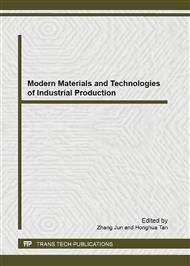[1]
Kowalczyk P, Gun'ko V M, Terzyk A P et al. The comparative characterization of structural heterogeneity of mesoporous activated carbon fibers(ACFs),. Applied Surface Science, vol. 206, (2003), pp.67-77.
DOI: 10.1016/s0169-4332(02)01189-3
Google Scholar
[2]
G.J. Lee, S.I. Pyun, C.K. Rhee. Characterisation of geometric and structural properties of pore surfaces of reactivated microporous carbons based upon image analysis and gas adsorption,. Micropor. Mesopor. Mater. vol. 93(2006), pp.217-225.
DOI: 10.1016/j.micromeso.2006.02.025
Google Scholar
[3]
A. Moropoulou, E.T. Delegou, V. Vlahakis, Digital processing of SEM images for the assessment of evaluation indexes of cleaning interventions on Pentelic marble surfaces. Mater. Charact. Vol. 58( 2007), pp.1063-1069.
DOI: 10.1016/j.matchar.2007.04.021
Google Scholar
[4]
D.S. Raimundo, P.B. Calope D.R. Huanca, W.J. Salcedo, Anodic porous alumina structural characteristics study based on SEM image processing and analysis, Microelectronics Journal, vol. 40(2009), p.844–847.
DOI: 10.1016/j.mejo.2008.11.024
Google Scholar
[5]
Weina Suna, Tao Chenb, Cuixian Chena. A study on membrane morphology by digital image processing, Journal of Membrane Science, vol. 305(2007), pp.93-102.
Google Scholar
[6]
Park Chiwoo, Jianhua Z. Huang, Jim Ji, Yu Ding, Segmentation, Inference and Classification of Partially Overlapping Nanoparticles, IEEE Transactions on Pattern Analysis and Machine Intelligence, vol. 35(2013), pp.1-14.
DOI: 10.1109/tpami.2012.163
Google Scholar
[7]
Rafael C Gonzalez, Richard E Woods. Digital image processing. 3rd ed., Publishing House of Electronic industry, (2003).
Google Scholar
[8]
Hatalick R, Zhuang X. Image analysis using mathematical morphology. IEEE Transaction on Pattern Analysis and Machine Intelligence, vol. 9(1987), pp.532-550.
DOI: 10.1109/tpami.1987.4767941
Google Scholar
[9]
Yan C X,Sang N,Zhu T X. Local entropy-based transition region extraction and thresholding. Pattern Recognition Letters, vol. 24(2003), pp.2935-2941.
DOI: 10.1016/s0167-8655(03)00154-5
Google Scholar
[10]
J. Canny, A computational approach to edge detection, IEEE Trans on Pattern Analysis and Machine Intelligence, vol. 8(1986), p.679–698.
DOI: 10.1109/tpami.1986.4767851
Google Scholar
[11]
D. Marr, E. Hildreth, Theory of Edge Detection, Proc. R. Soc. Lond., vol. B207(1980), pp.187-217.
Google Scholar
[12]
Malladi R, Sethian J A, Vemuri B C. Shape modeling with front propagation: A level set approach. IEEE Transactions on Pattern Analysis and Machine Intelligence, vol. 17 (1995), pp.158-175.
DOI: 10.1109/34.368173
Google Scholar
[13]
Caselles V, Kimmel R, Sapiro G. Geodesic active contours. International Journal of Computer Vision, vol. 22(1997), pp.61-79.
DOI: 10.1109/iccv.1995.466871
Google Scholar
[14]
Chunming Li, Chiu-Yen Kao, John C. Gore, and Zhaohua Ding. Implicit Active Contours Driven by Local Binary Fitting Energy. IEEE Trans. Computer Vision and Pattern Recognition, vol. 7 (2007), pp.1-7.
DOI: 10.1109/cvpr.2007.383014
Google Scholar


